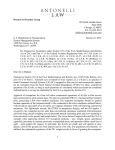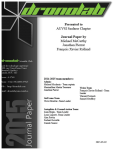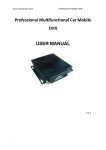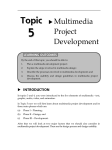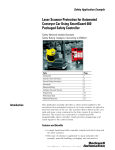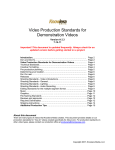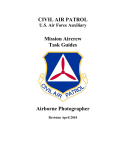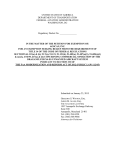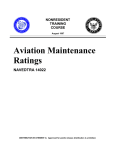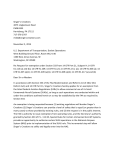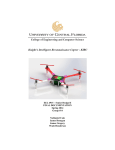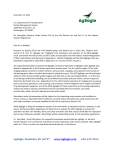Download Bryan_W_Swann_-_Exemption_Rulemaking
Transcript
January 24, 2015 To whom it may concern at the FAA: I would like to start by giving a brief description of myself. I am a 33 year old father of two children and I consider myself a professional adult. I am hoping to take piloting an unmanned aerial system beyond the point of hobby and into a professional occupation. I have spent the past 12 years of my life in the field of aviation as a contractor for DynCorp International at PAX River NAS. I am currently the assistant IMRL manager for a helicopter based squadron and I understand the seriousness of safety in aviation. I have been intrigued by remote control quadcopters since they began making them more user friendly. I purchased a DJI Phantom not long after they were released 2 years ago. I have flown it for probably 250 hours or more and feel very experienced with it. They are a fun and addictive system with the potential to be a valuable business tool. What could be a better way to make money doing something that I consider fun? I began taking pictures with a camera attached to it not long after I purchased it. I took pictures for numerous family and friends and looked into doing it professionally for real estate. In this area of MD, there’s a lot of real estate bought and sold due to being near a very large Navy base. The area is beautiful as well and it really gives you a different perspective from the air. Most of St. Mary's county is surrounded by water. I found that there was not really any way of doing it professionally because the rules had not been written. I kept checking back periodically and eventually found my way here. I got wind of a realtor just getting an approved COA and jumped at the opportunity. My petition is basically going to shadow that of Mr. Trudeau. After reading over his grant of exemption, he has described basically everything I wish to do. I am not a realtor however, and if and when I were to receive a grant of exemption, I would take on a position of photographer, videographer, and editor. I do not have a business yet but receiving a grant would be the final step before starting one. I also plan to purchase a different model of quadcopter to use than that of Mr. Trudeau. Same manufacturer as his, but a more advanced and updated system. It has not been released to the public yet but will be soon, maybe by the time you read this. It is also manufactured by the same company that made my first quad, the original DJI phantom. Funding has been approved by the treasurer (my wife) and by the time I would receive exemption, I should already have many hours of flight time with the UAS. In the attachments will be the DJI Inspire user manual, a link to the UAS, and a few pictures I have taken with the original Phantom for examples of the potential for real estate photography. I will begin the petition for exemption below: To the Federal Aviation Authority (FAA), I hereby request exemption from part 21, subpart H; and Sections 45.23(b), 61.113(a) and (b), 91.7(a), 91.9(b)(2), 91.103(b), 91.109, 91.119, 91.121, 91.151(a), 91.203(a) and (b), 91.405(a), 91.407(a)(1), 91.409(a)(2), and 91.417(a) and (b) of Title 14, Code of Federal Regulations (14 CFR). I support my request with the following information: I plan to operate a UAS, the DJI Inspire 1, which is comprised of an unmanned aircraft and a transportable ground station. The Inspire 1 is referred to as a quad-copter with a maximum gross weight of about 3 kilograms. It is equipped with four rotors that are driven by electric motors powered by a battery. The UA has a maximum airspeed of 22 m/s. The quad has a built in high definition camera. I plan to operate the UA over various areas near Great Mills, Maryland to enhance academic community awareness and augment real estate listing videos and photographs. I make the following representations of operational enhancements which I propose to abide by to ensure this exemption will provide a level of safety at least equal to existing rules: • I will only operate in reasonably safe environments that are strictly controlled, are away from power lines, elevated lights, airports and actively populated areas; and • I will conduct extensive preflight inspections and protocols, during which safety carries primary importance. I state that given the size, weight, speed, and limited operating area associated with the aircraft to be utilized, an exemption from 14 CFR part 21, Subpart H (Airworthiness Certificates) and § 91.203 (a) and (b) (Certifications required), subject to certain conditions and limitations, is warranted and meets the requirements for an equivalent level of safety under 14 CFR part 11 and Section 333 of P.L. 112-95 (Section 333). I request an exemption from § 45.23 Marking of the aircraft because his UA will not have a cabin, cockpit or pilot station on which to mark certain words or phrases. Further, I state that two-inch lettering is difficult to place on such a small aircraft with dimensions smaller than the minimal lettering requirement. Regardless of this, I state that I will mark his UAS in the largest possible lettering by placing the word “Experimental” on its fuselage as required by § 45.29(f) so that he or anyone assisting him as a spotter will see the markings. I state that an exemption from §§ 91.405(a), 91.407(a)(1), 91.409(a)(2) and 91.417(a) and (b) Maintenance inspections may be required and should be granted since they only apply to aircraft with an airworthiness certificate. However, I state that as a safety precaution I will perform a preflight inspection of his UAS before each flight as outlined in my operating documents. UAS Pilot in Command (PIC) I assert that under § 61.113 (a) and (b) private pilots are limited to noncommercial operations, however I can achieve an equivalent level of safety as achieved by current regulations because my UAS does not carry any pilots or passengers. Further, I state that, while helpful, a pilot license will not ensure remote control piloting skills. I further indicate that the risks of operating a UAS are far less than the risk levels inherent in the commercial activities outlined in 14 CFR part 61, et seq., thus I request an exemption from § 61.113 Private Pilot Privileges and Limitations: Pilot in command. Regarding UAS operational training, I state I have flown numerous practice flights in remote areas as a hobbyist simulating flights for future commercial use to gain familiarization with the characteristics of his UAS’ performance under different temperature and weather conditions. I further state that he practices computerized simulated flights to maintain adequate skills and response reflex time. In a supplemental request to the FAA, I request consideration of a 120 day temporary airman certificate in accordance with § 63.13, to allow time to obtain a private pilot certificate or to allow the FAA time to establish minimum UAS airman certification standards. UAS Operating Parameters I will abide by the following additional operating conditions under this exemption: • operate my UAS below 300 feet and within a radius distance of 1000 feet from the controller to both aid in direct line of sight visual observation; 1 • operate the UAS for 3-7 minutes per flight; • land my UAS prior to the manufacturer’s recommended minimum level of battery power; • operate my UAS only within visual line of sight (VLOS); • use the UAS’ global positioning system (GPS) flight safety feature whereby it hovers and then slowly lands if communication with the remote control pilot is lost; • conduct all operations under my own personal and flight safety protocols (including posting a warning sign reading: “Attention Aerial Photography in Progress – Remain Back 150 feet”) contained in the operating documents and will actively analyze flight data and other sources of information to constantly update and enhance my safety protocols; • contact respective airports if operations will be within 5 miles to advise them of my estimated flight time, flight duration, elevation of flight and other pertinent information; • always obtain all necessary permissions prior to operation; and • have procedures in place to abort flights in the event of safety breaches or potential danger. I state that § 91.7(a) prohibits the operation of an aircraft without an airworthiness certificate. I assert that since there is currently no certificate applicable to my operation, this regulation is inapplicable. I state that § 91.9(b)(2) requires an aircraft flight manual in the aircraft, however since there are no pilots or passengers on board his aircraft and given its size, this regulation is inapplicable. I further indicate an equivalent level of safety will be achieved by maintaining a safety/flight manual with the UAS ground station. I state that § 91.119 prescribes safe altitudes for the operation of civil aircraft, but that it allows helicopters to be operated at lower altitudes in certain conditions. I state that I will not operate his UAS above the altitude of 300 feet above ground level (AGL) and will also only operate in safe areas away from the public and traffic, thus “providing a level of safety at least equivalent to or below those in relation to minimum safe altitudes. I assert that given the size, weight, maneuverability, and speed of my UAS, an equivalent or higher level of safety will be achieved. I indicate that § 91.121 Altimeter settings is inapplicable since my UAS utilizes electronic GPS with a barometric sensor. Public Interest I state that aerial videography and photography for geographical awareness and for real estate marketing has been around for a long time through manned fixed wing aircraft and helicopters, but for small business owners, its expense has been cost-prohibitive. Granting this exemption to myself would allow me to provide this service at a much lower cost. Further, I would like to indicate my small UAS will pose no threat to the public given its small size and lack of combustible fuel when compared to larger manned aircraft. I would also like to state that the operation of my UAS will minimize ecological damage and promote economic growth by providing information to companies or individuals looking to relocate or build in the Southern Maryland region. (end of petition) I would like to conclude by saying thank you for your consideration and time reading this over. This has been a dream of mine since quadcopters became available to the public. I have only flown as a hobby to not break any laws until with hopes to become commercial. I see nothing but positive coming from it from top to bottom. The state of Maryland makes money from the sale of real estate. The realtor would have an advantage because of a much clearer view of properties. The consumer gets a better look at things. I get to pursue hopefully a career and be a pioneer in a virtually new field of photography. All along, the way the federal government collects taxes from all of us. The economy benefits with very little risk of accidents and/or damages from flying over the usually vacant areas of real estate. Thank you again. Very respectfully, Bryan W. Swann





